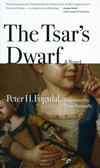The Tsar’s Dwarf
The Tsar’s Dwarf is Danish author Peter H. Fogtdal’s first novel to be translated into English. Sørine Bentsdatter, Fogtdal’s unusual heroine, is brilliantly rendered. A deformed female dwarf living in the early 18th century, Sørine is wittily acerbic, angry, and indifferent. She’s also shrewd, sensitive, and fiercely intelligent. At times she’s compassionate and almost kind; at others, her actions are questionable, even deplorable. Always, Sørine is human.
The Tsar’s Dwarf is Danish author Peter H. Fogtdal’s first novel to be translated into English. Sørine Bentsdatter, Fogtdal’s unusual heroine, is brilliantly rendered. A deformed female dwarf living in the early 18th century, Sørine is wittily acerbic, angry, and indifferent. She’s also shrewd, sensitive, and fiercely intelligent. At times she’s compassionate and almost kind; at others, her actions are questionable, even deplorable. Always, Sørine is human.
She lives in a time far less tolerant than our own; society considered her an oddity and constantly scorned her for her freakishness. She’s given as a gift from the King of Denmark to the Tsar of Russia, Peter Alexeyevich (Peter the Great), a notoriously ruthless and captivating ruler, known for his love of human deformities and collection of dwarves.
Called “Surinka” by the Tsar, Sørine finds herself drawn to his power, intelligence, and wit. He’s also a kindred spirit as the bearer of an abnormal affliction himself. She travels with the Tsar and his entourage from Copenhagen to Amsterdam to “the frozen melancholy of Petersburg.” There, she meets the Tsar’s favorite dwarf, Lukas, and finds herself repulsed by his pride, his sexual advances, and continual denial that he’s a dwarf.
Throughout, Sørine is tormented with guilt for drowning her son Mathias, who exhibited symptoms of the plague. She’s also haunted by disturbing visions of Mathias’ dead father, Terje the Scoundrel, a man she lived with in Copenhagen who was “fond of misshapen females.” Ultimately sent to a cloister to exorcise her demons, Sørine reflects:
There is a mushroom that grows only in the winter. It grows as a parasite on dead trees. Contrary to what people believe, it’s not poisonous. It was born at the wrong time – too late to be an autumn mushroom, too early to be part of the spring. From its place it hears the screams of the dying mushrooms. It hears their sorrows and lamentations.
If I were not a dwarf, I would be that sort of mushroom. I would be cold and slimy; I would renounce the sun. I would live on my tree trunk without distinguishing night from day. I would surrender myself to snails and insects. Death would never frighten me. I would reappear winter after winter, yellow as the sun, and with new gills.
Sørine, of course, is like this mushroom. Born at the wrong time in history, she acutely feels the pain of others, all the more so because she bears the brunt of humanity’s discontent.
Fogtdal deftly explores the experiences of the marginalized in this strangely uplifting and lyrical tale. The Tsar’s Dwarf also examines the power of the human spirit and, through his defiantly spirited narrator, shares the essence of what it means to be human.




